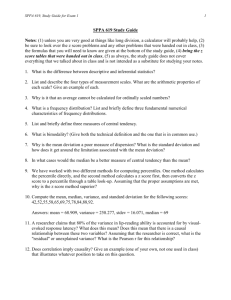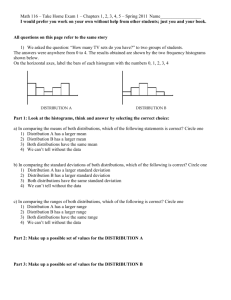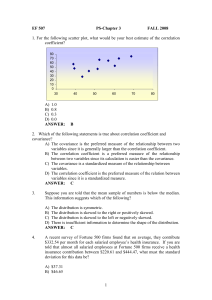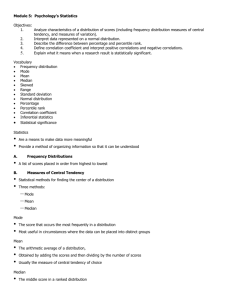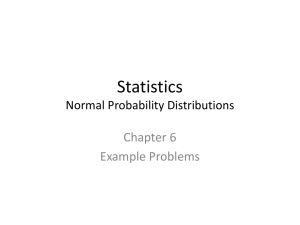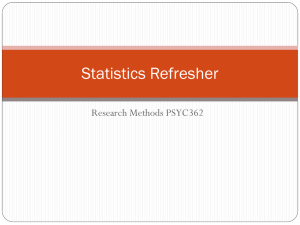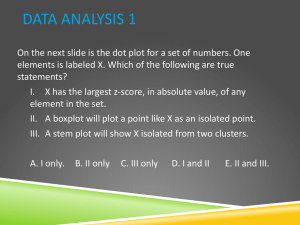Basic Statistical Concepts - new
advertisement
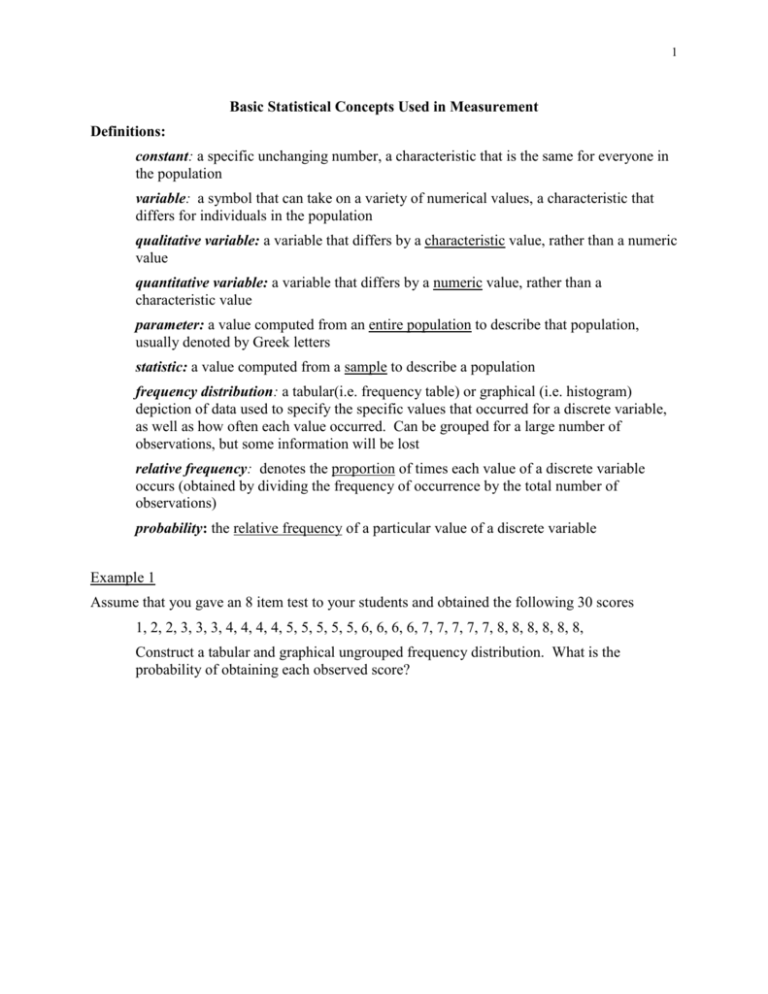
1 Basic Statistical Concepts Used in Measurement Definitions: constant: a specific unchanging number, a characteristic that is the same for everyone in the population variable: a symbol that can take on a variety of numerical values, a characteristic that differs for individuals in the population qualitative variable: a variable that differs by a characteristic value, rather than a numeric value quantitative variable: a variable that differs by a numeric value, rather than a characteristic value parameter: a value computed from an entire population to describe that population, usually denoted by Greek letters statistic: a value computed from a sample to describe a population frequency distribution: a tabular(i.e. frequency table) or graphical (i.e. histogram) depiction of data used to specify the specific values that occurred for a discrete variable, as well as how often each value occurred. Can be grouped for a large number of observations, but some information will be lost relative frequency: denotes the proportion of times each value of a discrete variable occurs (obtained by dividing the frequency of occurrence by the total number of observations) probability: the relative frequency of a particular value of a discrete variable Example 1 Assume that you gave an 8 item test to your students and obtained the following 30 scores 1, 2, 2, 3, 3, 3, 4, 4, 4, 4, 5, 5, 5, 5, 5, 6, 6, 6, 6, 7, 7, 7, 7, 7, 8, 8, 8, 8, 8, 8, Construct a tabular and graphical ungrouped frequency distribution. What is the probability of obtaining each observed score? 2 summation sign: (Greek capital letter sigma) used to symbolize the summation of discrete variable from the lower limit (denoted at the bottom of ) to the upper limit (denoted at the top of ). Example: Let X represent exam scores and let Xi represent the exam score for student i. Assume we have 5 students with the following scores: 34, 50, 41, 39, and 45. Then: 5 X i 1 i 34 50 41 39 45 209 and 5 X i 1 2 i 34 2 50 2 412 39 2 45 2 8,883 and 2 5 X i (34 50 41 39 45) 2 209 2 43,681 i 1 central tendency: a measure of where the center of a distribution lies - the three most commonly used indices of central tendency are mean, median, and mode. mean: the average of all observations, denoted by for a population and X for a sample N Xi i1 N where N = the number of observations in the population Can be thought of as the balancing point of the distribution Is greatly affected by skewness because each and every score affects it Is unbiased, meaning when calculating from a sample it does not systematically over or under estimate the population mean Is the preferred measure for test score distributions because for many of the distributions encountered in testing it is more stable then either the median or the mode median: the value that half of the observations fall at or below, preferred measure of central tendency for highly skewed distribution Is not sensitive to the magnitude of outliers or extreme values Is the preferred measure of central tendency with skewed distributions mode: the most frequently occurring observation Not a very reliable or stable measure with quantitative data Is the preferred statistic for qualitative data 3 Example 2: Calculate the mean, median and mode from the observed test scores given in the Example 1 variability: a measure of the degree to which observations vary – the three most commonly used indices of variability are range, variance, and standard deviation range: the difference between the largest and smallest observation occurring in the distribution deviation score: the difference, or distance, between an individual score and the group’s mean, denoted by x (i.e. x = X - variance: the average squared deviation score, denoted by 2 for a population and s2 for a sample N 2 X i 1 2 i N where N = number of observations standard deviation: the square root of the variance (denoted by for a population and by s for a sample) which represents the average difference between observations and the mean – this is usually easier to interpret because it is expressed in linear units, rather than squared units. Example 3: Calculate the range, variance, and standard deviation of the observations given in the Example 1 4 normal distribution: a theoretical symmetrical distribution for continuous variables that follows a bell shaped curve with many observations near the middle and fewer scores at the extreme. In this distribution the mean = median = mode uniform distribution: a distribution for which every value has the same relative frequency, in other words has an equal probability of occurring. This distribution has no mode and the mean = median positively skewed distribution: a distribution in which only a few of the observations are in the upper range of scores. Typically in this distribution the mean > median > mode negatively skewed distribution: a distribution in which only a few of the observations are in the lower range of scores. Typically in this distribution the mean < median < mode unimodal distribution: a distribution with only one mode. Most distributions are unimodal, including the normal distribution and skewed distribution bimodal distribution: a distribution with two modes. Many times distributions are called bimodal even if there are not two true modes. Describing the Relationship Between Two Variables Pearson correlation coefficient: a measure of the linear relationship between two variables, X and Y represented by xy for a population and rxy for a sample. N xy (X i 1 X )(Y Y ) N X Y Correlation coefficients can only take on values between –1 and +1 A large negative correlation coefficient (i.e. close to –1) represents a strong negative linear relationship while a large positive correlation (i.e. close to 1) represents a strong positive linear relationship A correlation close to zero represents little or no linear relationship The square of the correlation coefficient represents how much of the variance of one variable (say Y) is accounted for by its linear relationship with another variable A strong correlations does not imply a causal relationship 5 Restriction of range of one or both of the observed variables causes the correlation to be smaller than it would have been if the entire range of observations were used, referred to as attenuation. If the relationship between variables differs across groups and the groups are combined then the correlation for the combined groups might be misleading Example 4 Calculate the correlation coefficient for the following data. Note that the mean of Test A = 6, the mean of Test B = 25.2, the standard deviation of Test A = 1.58 and the standard deviation of Test B = 5.89 Test A 5 7 8 4 6 Test B 21 32 30 25 18
